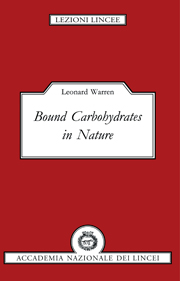1 - The carbohydrates of glycoproteins
Published online by Cambridge University Press: 02 February 2010
Summary
Living matter consists largely of water and complex polymers of amino acids, lipids, nucleotides and carbohydrates. Carbohydrate polymers are special in that they are usually associated with the three other polymers. They are stably linked with amino acid polymers (proteins) or with lipids as glycolipids that participate in non-covalently-linked associations, the lipid bilayer of biological membranes. DNA and RNA are, in essence, polymers of d-ribose-phosphate and 2-deoxy-d-ribose-phosphate to which are attached purine and pyrimidine bases at the C-1 reducing position. While the synthesis of proteins and nucleic acids is guided by a template to maximize fidelity of product formation, synthesis of carbohydrate and lipid membrane polymers, which perform a more structural function, is not. As will be discussed, a variability and relative lack of quality control in the making of lipid and carbohydrate polymers may have its special role in the operation of organisms in an environment that is variable and unpredictable.
Sugars almost certainly existed before life itself appeared on Earth. It has been known for over a century that many sugars can be formed from formaldehyde in alkaline solution. Condensation of formaldehyde, most probably a prebiotic constituent, has been carried out in the laboratory to form glycoaldehyde, trioses, tetroses, pentoses, and hexoses. Polymerization of formaldehyde can be catalyzed by surfaces provided by insoluble silicates and carbonates. UV light, electric discharge and ionizing radiation at the right pH and temperature may also promote synthesis of sugars.
- Type
- Chapter
- Information
- Bound Carbohydrates in Nature , pp. 1 - 22Publisher: Cambridge University PressPrint publication year: 1994



